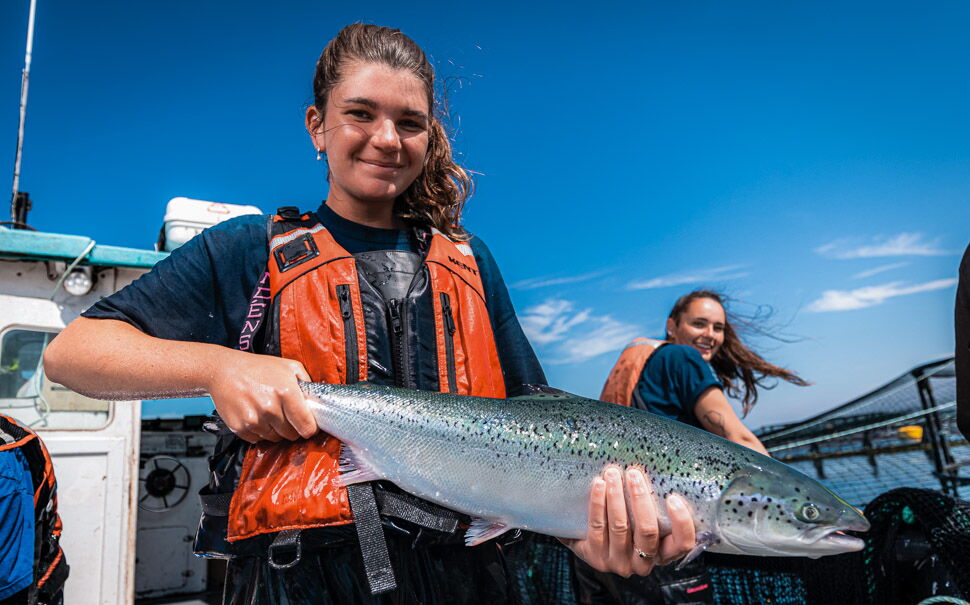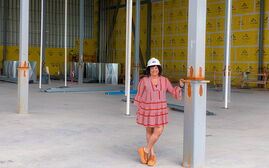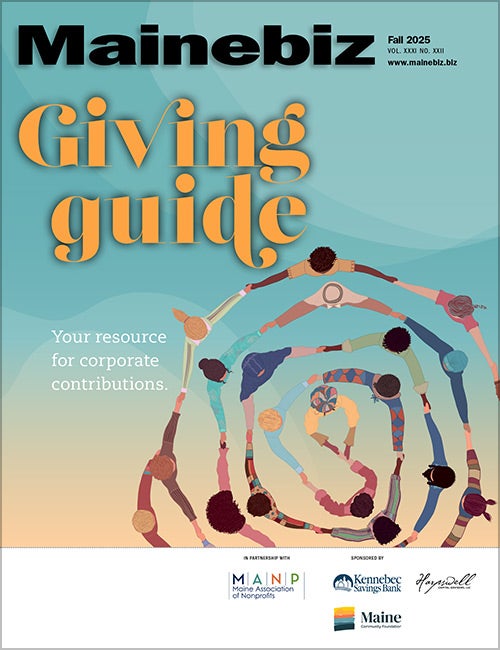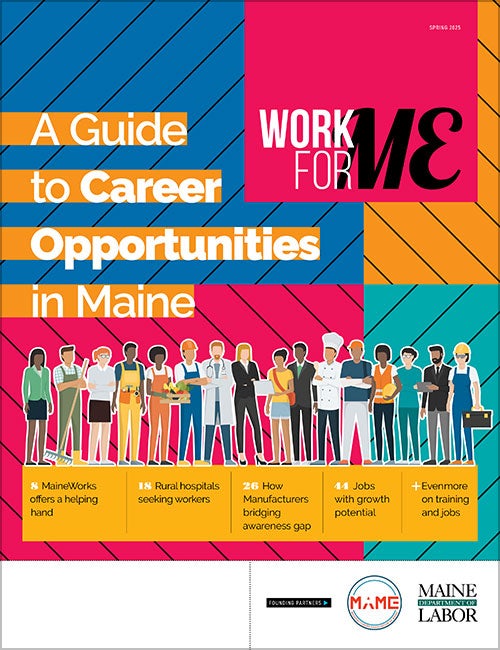
The newest ingredient in food innovation: AI is giving Maine producers an edge
 PHOTO / COURTESY OF COOKE USA
Cooke USA Fish Health Technician Jaelyn Matthews (right) with Megan Robinson weighing fish at a Machias Bay salmon farm.
PHOTO / COURTESY OF COOKE USA
Cooke USA Fish Health Technician Jaelyn Matthews (right) with Megan Robinson weighing fish at a Machias Bay salmon farm.
Artificial intelligence in the food sector is experiencing rapid growth. The market, valued at $6.4 billion in 2024, is projected to rise to $8.6 billion by 2025 and reach $27.7 billion by 2029, according to one estimate.
The global IT firm WhaTech, which compiled the estimates, attributes the surge in adoption to several factors: rising demand for automation, improvements in supply chain efficiency, stronger emphasis on food safety and regulatory compliance, growing consumer expectations and pressure to reduce costs while boosting operational performance.
Rather than replacing human labor, AI is helping food producers refine climate controls for crops and aquaculture systems and opening doors to more inclusive job opportunities for workers with disabilities.
Here in Maine, AI-driven food technology is increasingly shaping how our food is produced every day, redefining the meaning of “locally produced.”

Technology drives healthier fish farming practices

Founded in 1985 with a single farm and 5,000 Atlantic salmon, Cooke USA has grown into a global seafood producer with operations around the world. In Maine, the company recently marked its 20th anniversary, operating marine farms Downeast, including a salmon processing plant in Machiasport and three land-based freshwater hatcheries in both western and eastern parts of the state.
Today, Cooke is piloting artificial intelligence across its farms to advance nearly every aspect of aquaculture. AI tools are being used to improve feed efficiency, estimate biomass, track growth, detect parasites and monitor environmental conditions. In hatcheries, technology also aids in gender and defect detection in juvenile fish, a process that previously relied on manual, visual inspection.
Although aquaculture is only about 50 years old, the industry is already embracing transformative technology. Feeding once relied entirely on manual labor and approximation, often resulting in waste and overfeeding. Now, underwater cameras and sensors analyze fish behavior in real time, with algorithms determining the optimal timing for feed release.
Maintaining healthy fish stocks also means confronting threats such as sea lice and algae blooms. To address this, Cooke is testing an AI-enabled monitoring system capable of identifying microscopic algae bloom species in real time, including whether they are harmful or harmless. This early detection allows the company to take rapid action, protecting fish health and minimizing loss.
“It’s better for the bottom line; it’s better for our fish. Our fish are healthier. We’re able to take better care of them. It’s better for our employees because their jobs become less manual and they can focus on other tasks. They get excited about using new tools and technology. It’s a win all around,” says Steven Hedlund, director of public affairs for Cooke USA.
According to Hedlund, AI is proving central to precision farming. By collecting and analyzing data, technology helps farmers anticipate and manage the many risks involved in raising fish. “You know things happen when you’re farming animals and you’re just avoiding a lot of those things by using the latest technology. We’re being more efficient and smarter about what we’re doing,” he explains.
Aquaculture also presents unique challenges for AI. Systems must be rugged enough to withstand boats, storms and the harsh marine environments, making fish farms an innovative testing ground for new technology.

Ultimately, the goal is not only to improve production but also to strengthen community trust.
“It’s not just about the bottom line. It’s about being accepted by the community as part of the working waterfront and as an employer, and the good things that come from food production and employment,” Hedlund notes. “We’re always trying to tell people aquaculture is agriculture, and we face the same sort of challenges that terrestrial farmers face.”

Farm fresh produce in urban spaces
Originating in Jackson, Wyo., the hydroponics farm Vertical Harvest has established its latest location in Westbrook, where it is projected to produce 2 million pounds of leafy greens annually. The four-story, 52,000-square-foot farm is now operational, with produce expected to reach vendors soon after commissioning local farm systems in the summer of 2025.
At the heart of its mission, Vertical Harvest aims to bring fresh food to urban areas, reducing food deserts while using technology to create jobs that expand accessibility, particularly for individuals with disabilities.

“Vertical Harvest didn’t just set out to grow greens. We set out to design a new kind of infrastructure,” says Nona Yehia, co-founder and CEO of Vertical Harvest.
“The food system is under immense pressure,” she notes. “Land is disappearing, climate shocks are more frequent and supply chains are increasingly brittle and fragile. We believe that farms should be treated like utilities. That critical infrastructure is embedded in cities to serve communities directly. So, we use technology to create a global prototype that can address these issues and create a smart, resilient, inclusive food system.”
Through a partnership with Siemens, Vertical Harvest is developing advanced automation and data collection systems with its manufacturing execution system. Every growing tray is equipped with sensors that capture millions of data points on the plants and their environment. This data is then transformed into action, with AI applied to yield forecasting and environmental adjustments in real time, ultimately producing stronger, healthier plants.

“The proprietary Vertical Harvest Crop Intelligence System brings together machine learning models trained on climate, crop and yield data and computer vision to understand crop morphology and predict outcomes and recipe optimization activation tools that will help us tweak light, water and air flow and nutrients for maximum efficiency. What’s beautiful about this system is that it’s the flexibility that we’re growing. It’s crop agnostic, it’s location agnostic, and it’s continuously learning,” Yehia says.
This ability to monitor and adjust conditions is especially important in controlled indoor growing environments where climate regulation directly affects crop performance. At the same time, Vertical Harvest is intentionally using technology to create new opportunities in the workforce.
Automation of physically demanding tasks allows a more diverse range of people to participate in greenhouse operations. AI also helps analyze workflow, accessibility, and pace consistency, tailoring job assignments to individual strengths while balancing operational needs.
“We’re learning about the ability of people to do the jobs as they’re doing the job,” Yehia says. “So, we’ll improve the jobs, and then we’ll improve the way that the people are doing the jobs. We can adjust the roles to minimize stress and fatigue on the workers’ part, especially with neurodiverse team members, so that helps reduce turnover, improve performance and elevate people into supervisory roles who were previously excluded from the workforce entirely. It’s the machines and the people learning together.”
Yehia also addresses some misconceptions about AI in the food sector.

While some may assume AI leads to artificial food or detaches production from human expertise, she argues the opposite is true. AI is simply a tool that gathers and interprets data, working alongside farmers and employees to grow food more sustainably, precisely, and with less waste.
“I believe AI will help us to grow food in places where we can be land efficient, water efficient and energy efficient,” she says.
“I think that AI will also help us get the best food possible to the people. I’m also really excited about AI’s ability to provide food for cities. There are so many food deserts across the United States and the globe. It is about using AI to really optimize yields and make sure people are getting fed where they live and to increase the resilience of our food system. We’re never going to replace traditional agriculture, but we can feed people closer to where they live.”















0 Comments